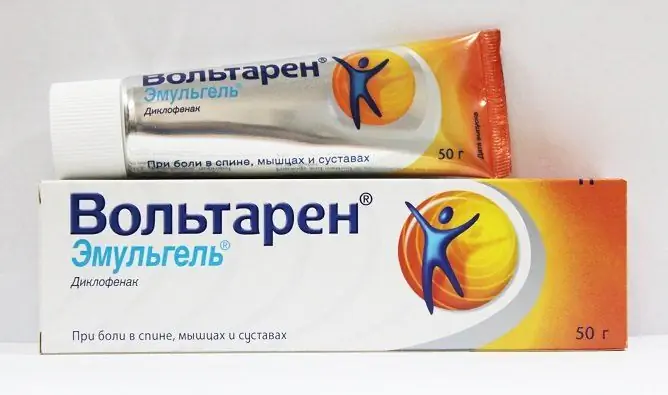- Author Rachel Wainwright [email protected].
- Public 2024-01-15 19:51.
- Last modified 2025-11-02 20:14.
Treatment of tinnitus with osteochondrosis of the cervical spine
The content of the article:
- Treatment
- Medications
- Why does tinnitus appear with cervical osteochondrosis
- Video
Treatment of tinnitus in osteochondrosis of the cervical spine is conservative, but to be successful, it must be comprehensive and individually selected. It is unacceptable to self-medicate, because in this case the effectiveness is extremely low, and the risk of complications, on the contrary, is very high.

Tinnitus in cervical osteochondrosis - a manifestation of the cochleo-vestibular syndrome
Treatment
The main cause of tinnitus in cervical osteochondrosis is associated with impaired blood circulation, so the treatment regimen is as follows:
| Method | Characteristic |
| Drug therapy | Drug therapy is aimed primarily at regulating vascular lumen and blood pressure. The group of medications used also includes drugs for symptomatic therapy (elimination of headache, inflammation, fibrosis). |
| Exercise therapy | Exercise indirectly affects the elimination of tinnitus. The mechanism and purpose of their appointment are associated with the stabilization of the intervertebral disc and the strengthening of the muscular frame (additional support function). This leads to a slight decrease in pressure on the vessels and partial normalization of blood circulation. A sick person will first feel the dullness of pain in the head and neck, and only then get rid of other symptoms of pathology, such as extraneous sounds in the ears. |
| Physiotherapy methods |
They are prescribed to relieve local inflammatory processes. They are partially able to restore metabolism in tissues and have a local vasodilating effect. They are unable to directly influence and cure deeper structures (vertebral arteries, in particular), but indirectly, due to the inclusion of collateral circulation, they bring some relief to the patient. Treatment options: Phonophoresis - a combination of ultrasound and topical preparations; · UHF - exposure to high-frequency electromagnetic field; · Electrophoresis - a combination of an electric field and drugs for local use; · Magnetotherapy - exposure to a strong magnetic field; · Myoreflexotherapy - impact on certain muscle groups; · Balneotherapy - impact on the body with water (baths, showers, mud therapy); · Spa treatment. |
| Massage | Acts on the elimination of tinnitus indirectly. Kneading and rubbing muscles increases blood flow to the tissues and stimulates collateral circulation (nutrition of ischemic areas is improved by additional vascular branches). Removes muscle spasm and normalizes the mobility of the affected segment (short-lived action). It can be manual (classic, point, Thai, segmental-reflex) and hardware (vacuum-roller, vibration), as well as mixed. |
| Manual therapy |
Post-isometric relaxation is often used, which aims to restore normal muscle tone by stretching the muscles. The technique differs from a typical massage in its relaxing nature (the goal is not to warm up the muscle tissue, but to gently stretch). |
| Surgical intervention |
Disease in advanced stages (intervertebral hernia) may require radical treatment. If the disease spreads quickly, in the absence of the effect of conservative therapy, the following options for surgical treatment are possible: · Periarterial sympathectomy (ligation of the sympathetic trunk); · Decompression of the vertebral arteries; · Resection or total excision of damaged discs with possible prosthetics. The operation is performed only according to indications and after a thorough examination. |
Patients can be shown special orthopedic products (period of use from 1 to 3 months).
Medications
The principle of action of drugs is aimed at eliminating perivascular edema and stabilizing blood pressure and venous outflow.
The main drugs are the following (the regimen is selected individually):
|
Group of medicines |
Purpose | Example |
| Vasodilator tablets (vasodilators) | They are prescribed for the purpose of short-term dilatation of blood vessels and relieving an attack of cochleo-vestibular syndrome (paresthesia, hearing loss, paroxysmal non-systemic dizziness, feeling of instability, loss of consciousness, tinnitus, ear is laid on the right or left side). They can be prescribed as a course in order to restore normal blood circulation to the brain. | Pentoxifylline - 300-900 mg / day. |
| Non-steroidal anti-inflammatory drugs | Prescribed as one of the means that reduce edema around the great vessels. | Nimesulide - 100-200 mg / day, Celecoxib - 200-400 mg / day. |
| Medicines that improve venous outflow | Reduce manifestations of venous stasis | L-lysine escinate - 5 mg / day, Troxerutin - 600-900 mg / day. |
| Neuroprotective agents | Designed to eliminate the manifestations of oxygen starvation of the brain. | Actovegin - 200-1000 mg / day; Piracetam - 1200-2400 mg / day. |
| Metabolic agents | Designed to improve the nutrition of the affected areas of the brain. | Mildronate - 500-750 mg / day, Trimetazidine - 60 mg / day. |
| Drugs that stabilize blood pressure and hemodynamics | Prevention of sudden pressure surges is especially important in patients with a history of hypertension. | Used drugs of different groups: calcium antagonists (Cinnarizine - 75-150 mg / day.); alpha-blockers (Nicergoline - 30-60 mg / day), etc. |
Medicines from auxiliary groups:
| Group of medicines | Purpose | Example |
| Muscle relaxants | They reduce muscle spasm and thereby stabilize local blood circulation in tissues. | Tizanidine - 4-6 mg / day. |
| Antispasmodics | Similar action with muscle relaxants. | Drotaverine - 40-80 mg / day. |
| Histamine-like substances | They help to reduce local edema resulting from the inflammatory process. | Betahistine - 24-48 mg / day. |
| Anti-migraine drugs | The action is aimed at redistributing blood flow in the brain. | Sumatriptan - 100-300 mg / day. |
| B vitamins | Leads to improved brain function. | Many different vitamin complexes. |
The absence of pain allows the patient to resort to exercise therapy and physiotherapy.
Correctly selected conservative treatment allows you to gradually stabilize the affected area of the spine, and then, using several courses, to consolidate the result. This, in turn, will lead to the stabilization of blood flow in this segment and the disappearance of the manifestations of the cochleo-vestibular syndrome (noise and ringing in the ears).

Nimesulide is one of the drugs that can be prescribed as part of the complex therapy of cervical osteochondrosis
Why does tinnitus appear with cervical osteochondrosis
Osteochondrosis is a pathology of the intervertebral disc, which begins its development from the nucleus and gradually spreads to all elements of the vertebral motor segment. It is represented by a complex of specific disorders (present at any level of the lesion, but one segment dominates):
| Violation | Characteristic |
| Static violations | Associated with direct degenerative lesions in the disc area and impaired joint functionality. |
| Hemodynamic disorders | They arise when the vascular bundles passing in the immediate vicinity of the deformed vertebra are compressed. |
| Neurological disorders | They arise due to compression of nerve bundles, more often at the exit from the spinal cord (in the case of involvement of the spinal canal, compression of the roots in the spinal cord occurs). |
| Trophic disorders | Associated with a disruption of normal tissue metabolism due to chronic hypoxia (vasoconstriction, lack of oxygen and nutrients). |
Tinnitus in cervical osteochondrosis is caused by hemodynamic and trophic disorders that lead to ischemic processes in the brain. A cochleo-vestibular syndrome develops (tinnitus and ringing in the ears, hearing loss, hearing loss, a feeling of swaying and dizziness, a feeling that the ear is being laid), caused by damage to the centers in the brain without affecting the peripheral hearing organs.
This violation occurs exclusively with damage to the cervical spine, which is caused by the anatomical features of the blood circulation:
- From the vertebral artery spinal branches, posterior spinal arteries, anterior spinal arteries, which supply blood to the spinal cord and its membranes (prolonged ischemia and trauma, lead to the appearance of radicular symptoms). This is the reason for prescribing anesthetics and blockages.
- The posterior inferior cerebellar artery departs from the vertebral artery, which supplies blood to a part of the fourth ventricle, a region of the medulla oblongata and cerebellum, as well as branches to the dura mater of the posterior cranial fossa. This is the reason for prescribing metabolic drugs.
- The vertebral arteries at the level of the bridge are connected into a single vessel - the basilar artery. From it depart: the artery of the labyrinth, which goes to the inner ear and leads to the occurrence of noise and ringing in the ears, as well as to hearing loss; the anterior inferior cerebellar artery and the superior cerebellar artery, which goes to the cerebellum (partly to the choroid plexuses of the third ventricle) and causes a lack of coordination; the arteries of the pons and the posterior spinal arteries, which supply the corresponding structures. The reason for the appointment of the entire complex of drugs.
Thus, the treatment of tinnitus in osteochondrosis of the cervical spine does not require the prescription of drugs that affect the very elements of the auditory receptor (cochlea, auditory ossicles). It is required to prescribe drugs aimed at stabilizing the blood supply to the brain (after a course of therapy, the symptom disappears without a trace).
Video
We offer for viewing a video on the topic of the article.

Anna Kozlova Medical journalist About the author
Education: Rostov State Medical University, specialty "General Medicine".
Found a mistake in the text? Select it and press Ctrl + Enter.






